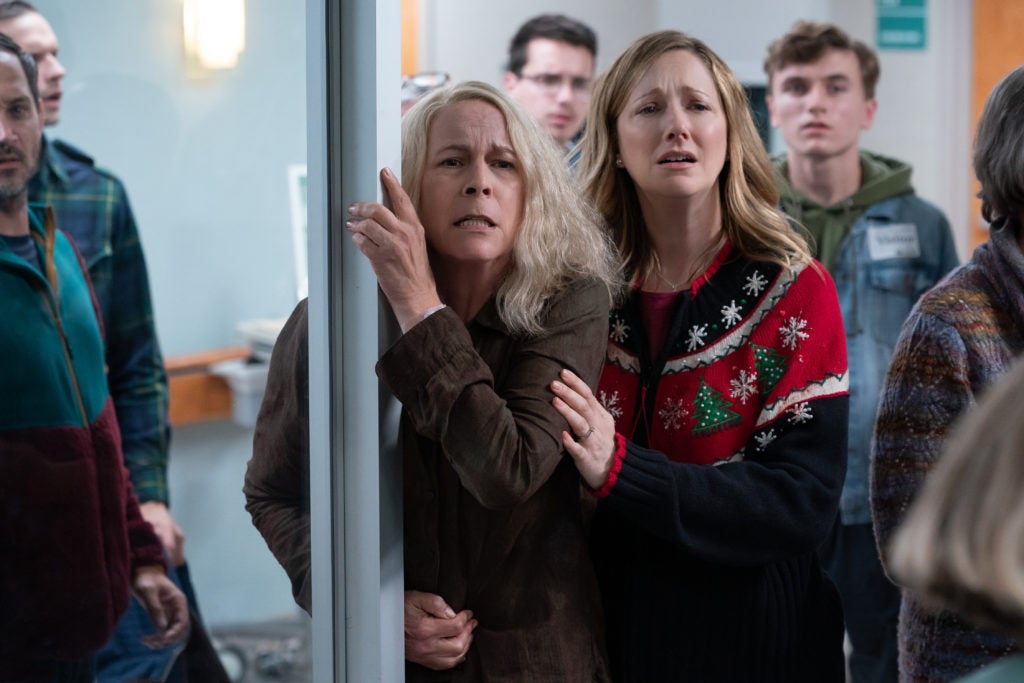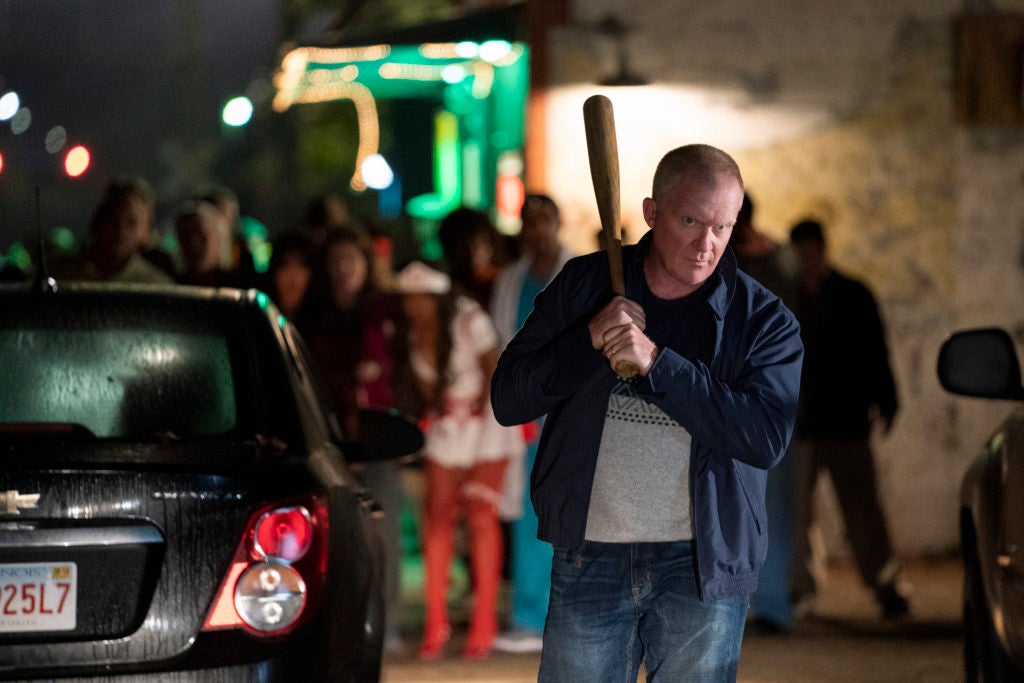Sometimes, a cigar is just a cigar, but in horror movies, the killer is almost never just a killer. Cinematic bogeymen are meant to represent larger societal fears — maybe it’s being young and horny, maybe it’s 9/11, maybe it’s toxic men, maybe it’s white people — and so the films allow us a way to process real-life terrors in the safety and comfort of the theater. But it’s less common when the killer turns the tables, revealing something terrible about the rest of us — arguing that, actually, we’re the true monsters. That’s a nervy strategy, and for a moment, I was intrigued that Halloween Kills decided to go for it. Here’s a movie very much about how horrible America is — how the fears that have built up around us have turned us into bogeymen — and while I’m sympathetic to that perspective, I wish it was being argued in a film a lot better than this.
Three years ago, director David Gordon Green made a very good direct sequel to John Carpenter’s brilliant 1978 original, which he also called Halloween, using #MeToo as a launching pad to explore the lingering trauma Laurie Strode (Jamie Lee Curtis) has endured since being attacked by Michael Myers in her youth. Green’s Halloween genuinely invested in its societal themes — plus, it stripped away any notion that Michael was anything more than a cruel sociopath, ensuring that his kills weren’t “cool” or “awesome” — and the new film picks up the action shortly after the events of the 2018 movie, still with plenty on its mind beyond slasher scares.
You may remember that Laurie, her daughter Karen (Judy Greer) and granddaughter Allyson (Andi Matichak) barely got out alive at the end of Halloween, with Michael presumed dead in a blazing house fire. Laurie is rushed to the emergency room for her injuries, but unbeknownst to the women, Michael is still alive. (Of course he is.) Naturally, Michael quickly gets back to killing — that’s his thing — and soon he’s made the local news, triggering some longtime Haddonfield residents who still grimly recall their first run-in with him back in 1978. One of them is Tommy (Anthony Michael Hall), a kid Laurie babysat that fateful night, and he’s determined to bring down the bastard, marshalling a group of bloodthirsty neighbors to take up arms against this monster. He’s even got a catchy chant: Evil dies tonight.
Once again Green is behind the camera — also once again, he and longtime collaborator Danny McBride worked on the script — and what’s best about Halloween Kills is its continuation of the 2018 film’s principled lack of fascination with Michael. There’s no complex psychological backstory, no hint of redeeming qualities within this walking nightmare. For the most part, his kills are just as vicious this time around, eschewing dark humor so that we never forget the sheer ugliness of his crimes. The violence is graphic, even gratuitous, but it rarely feels cheap or exploitative. Green wants you to be repelled by Michael — he wants you to hate this man who murders indiscriminately, and without any trace of compassion. Green wants you to join Tommy’s mob that’s ready to string Michael up.

All of this is happening away from Karen and Allyson as they keep a watchful eye on Laurie, who’s longing to get back into the fight. (She can’t rest until she knows Michael’s dead, even if she can barely get out of her hospital bed.) But even among the Strode women, there’s a feeling that Michael’s reign of terror has been so horrifying for so long that it has to end — that, in fact, no one will ever be able to get closure unless he dies. The only debate is about how best to do it: Karen insists Laurie stay in the hospital and let the police handle matters, while Laurie is convinced that Michael will come looking for her. As for Allyson, she decides to join the mob — this is personal for her, and she’s not about to wait around.
There’s a clever, subversive idea at the heart of Halloween Kills — for once, Michael is the prey — but Green bungles it badly. Fairly quickly, Green’s commentary becomes apparent, portraying the angry townspeople not as righteous individuals but, rather, frothing morons who want justice any way they can get it. As a result, several of Michael’s later kills happen because these idiots think they’ve tracked down the monster, only to discover that he’s way better at killing than they are. (Here’s a typical scene in Halloween Kills: “Hey, I think he’s over there! I’m gonna get him! Oh shit, I’m dead!”)
Beyond serving as an excuse to add to the body count, this approach is meant to make a fairly inelegant, obvious point about post-9/11 America: We’ve become a nation so afraid of everything that we just lash out erratically, hoping big shows of strength will somehow keep the scary things at bay. On one level, that observation is depressingly true — and the Trump years only exacerbated that reality, as immigrants and other persecuted groups were held up as scapegoats for the country’s dumbest citizens to demonize. Hell, “Evil dies tonight” could have been a rallying cry the former president’s supporters yelled at, say, journalists.

Unfortunately, it’s one thing to agree with a movie’s argument — it’s another to actually have to sit through said film as it beats you over the head with its message and increasingly annoying characters. Hall does his job too well as the reactionary, bullheaded Tommy: He’s an actively loathsome individual to be around, and several of the film’s convoluted complications occur because he whips the locals into a fury, leading to several of them getting killed and — in one especially manipulative sequence — the death of an innocent bystander. Clearly, Green is commenting on the awful hate crimes that have occurred in this country, especially since Trump’s rise to power, but it’s off-putting when a film parades its point in such a self-congratulatory, long-after-the-fact way.
Even worse, on a storytelling level the weak commentary gets away from some of what was most effective about Green’s Halloween, which was a horror film laced with a sharp cultural critique. By comparison, Halloween Kills is sometimes a horror film burdened with banal “Deplorables, amiright??!?” observations.
That said, I almost admired a twist that occurs near the end of this sequel, which I won’t reveal except to say that the mob will finally get to face off with Michael. In that moment, you can sense Green trying to make his audience question how we feel about slasher-movie villains and how they correspond to the daily terrors we grapple with that don’t wear masks or come bearing long, sharp kitchen knives. But as with so much of Halloween Kills, that twist mostly just plays out like a lot of horror sequels in general: It’s half of a good idea that’s been rushed through and not well-thought-out.
There’s no question America has more than its share of everyday monsters, but they’re rarely as boring as the ones on display here.

